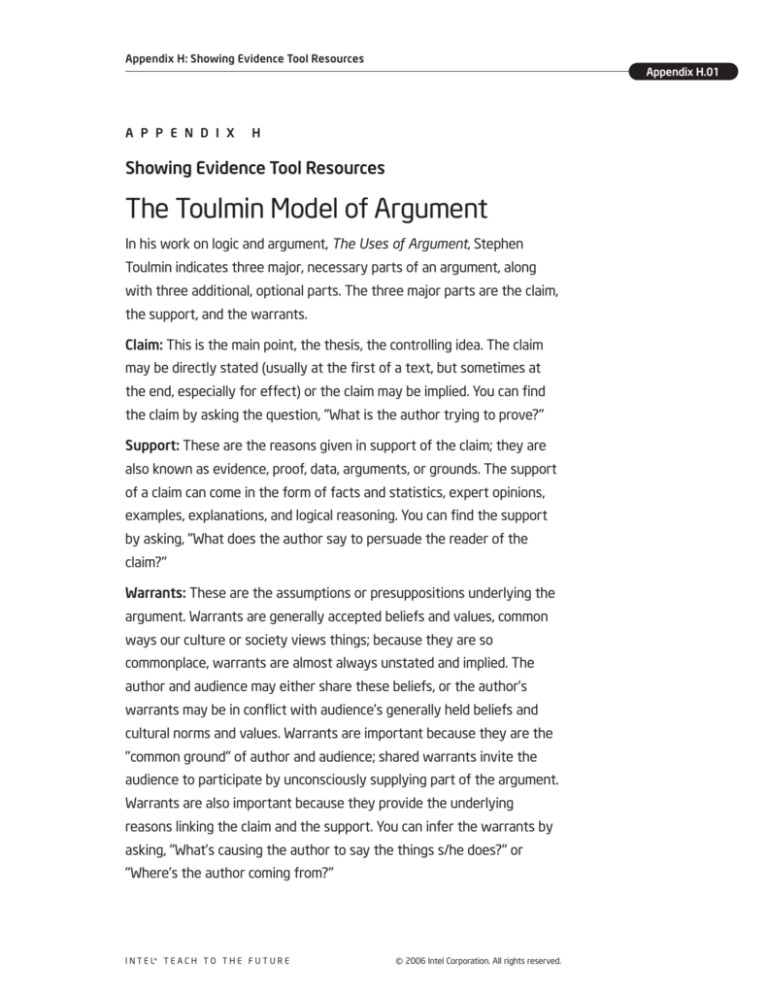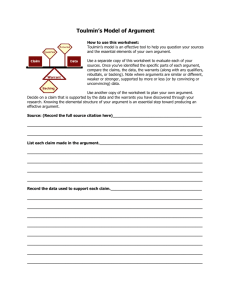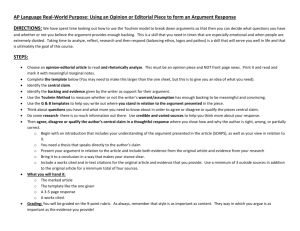
Appendix H: Showing Evidence Tool Resources
Appendix H.01
A P P E N D I X
H
Showing Evidence Tool Resources
The Toulmin Model of Argument
In his work on logic and argument, The Uses of Argument, Stephen
Toulmin indicates three major, necessary parts of an argument, along
with three additional, optional parts. The three major parts are the claim,
the support, and the warrants.
Claim: This is the main point, the thesis, the controlling idea. The claim
may be directly stated (usually at the first of a text, but sometimes at
the end, especially for effect) or the claim may be implied. You can find
the claim by asking the question, "What is the author trying to prove?"
Support: These are the reasons given in support of the claim; they are
also known as evidence, proof, data, arguments, or grounds. The support
of a claim can come in the form of facts and statistics, expert opinions,
examples, explanations, and logical reasoning. You can find the support
by asking, "What does the author say to persuade the reader of the
claim?"
Warrants: These are the assumptions or presuppositions underlying the
argument. Warrants are generally accepted beliefs and values, common
ways our culture or society views things; because they are so
commonplace, warrants are almost always unstated and implied. The
author and audience may either share these beliefs, or the author’s
warrants may be in conflict with audience’s generally held beliefs and
cultural norms and values. Warrants are important because they are the
"common ground" of author and audience; shared warrants invite the
audience to participate by unconsciously supplying part of the argument.
Warrants are also important because they provide the underlying
reasons linking the claim and the support. You can infer the warrants by
asking, "What’s causing the author to say the things s/he does?" or
"Where’s the author coming from?"
I N T E L® T E A C H T O T H E F U T U R E
© 2006 Intel Corporation. All rights reserved.
Appendix H: Showing Evidence Tool Resources
Appendix H.02
Here’s a visual representation and an example:
Claim
Support
Universities should reinstate
affirmative action admissions
policies.
Affirmative action provides
equal access to education
for all ethnic groups.
Warrant
Equality of access is a
basic American value.
In this example, the claim that universities should reinstate affirmative
action polices is supported by the reason that affirmative action
provides equal access for all ethnic groups. It’s generally acknowledged
by most Americans that equality of access is a basic American value.
There are three additional parts to Toulmin’s model of argument. Not
every one of these is used in every argument, but only as need arises.
Qualifiers: Because argument is about probability and possibility, not
about certainty, you should not use superlatives like all, every, absolutely
or never, none, no one. Instead you may need to qualify (tone down)
your claim with expressions like many, many times, some or rarely, few,
possibly.
Rebuttal: When making an argument, you must take into consideration
other conflicting viewpoints and deal with them fairly. You need to
answer questions and objections raised in the minds of the audience; if
you fail to do so, your own argument will be weakened and subject to
attack and counter-argument. Sometimes rebuttal will be directed to
opposing claims; other times rebuttal will be directed at alternative
interpretations of evidence or new evidence.
Backing: Sometimes the warrant itself needs evidence to support it, to
make it more believable, to further "back up" the argument.
These additional elements of argument may be added to our visual
representation as follows:
(Qualifier) Claim
(Rebuttal)
Support
Warrant
(Rebuttal)
(Backing)
© 2006 Intel Corporation. All rights reserved.
I N T E L® T E A C H T O T H E F U T U R E
Appendix H: Showing Evidence Tool Resources
Appendix H.03
Qualifier: If a university does not have a diverse student body
Claim: ...it should use affirmative action admissions policies.
Support: Affirmative action policies provide equal access to education
for all ethnic groups.
Warrant: Equality of access is a basic American value.
Backing: Equality before the law is a fundamental right of all Americans.
Rebuttal: Affirmative action policies do not result in "reverse
discrimination" because they are only part of a process that attempts to
ensure fairness in college admissions.
Five Categories of Claims
Argumentative essays are based on a claim, which almost always falls
into one of the five following categories.
1. Claims of fact. Is it real? Is it a fact? Did it really happen? Is it true?
Does it exist?
Examples: Global warming is occurring. Women are just as effective as
men in combat. Affirmative action undermines individual achievement.
Immigrants are taking away jobs from Americans who need work.
2. Claims of definition. What is it? What is it like? How should it be
classified? How can it be defined? How do we interpret it? Does its
meaning shift in particular contexts?
Examples: Alcoholism is a disease, not a vice. We need to define the term
family before we can talk about family values. Date rape is a violent
crime. The death penalty constitutes "cruel and unusual punishment."
3. Claims of cause. How did this happen? What caused it? What led up to
this? What are its effects? What will this produce?
Examples: The introduction of the computer into university writing
classes has enhanced student writing ability. The popularity of the
Internet has led to a rise in plagiarism amongst students. The economic
I N T E L® T E A C H T O T H E F U T U R E
© 2006 Intel Corporation. All rights reserved.
Appendix H: Showing Evidence Tool Resources
Appendix H.04
boom of the 1990s was due in large part to the skillful leadership of the
executive branch.
4. Claims of value. Is it good or bad? Beneficial or harmful? Moral or
immoral? Who says so? What do these people value? What value system
will be used to judge?
Examples: Doctor-assisted suicide is immoral. Violent computer games
are detrimental to children’s social development. The Simpsons is not a
bad show for young people to watch. Dancing is good, clean fun.
5. Claims of policy. What should we do? How are we to act? What policy
should we take? What course of action should we take to solve this
problem?
Examples: We should spend less on the prison systems and more on
early intervention programs. Welfare programs should not be dismantled.
The state of Oklahoma ought to begin to issue vouchers for parents to
use to fund their children’s education. Every person in the United States
should have access to federally-funded health insurance.
Adapted from Nancy Wood’s Perspectives on Argument, 2nd ed. (pp.161-172)
Just about any given topic can lend itself to be stated as one of the five
types of claims. For example, the topic of gun control could be
approached from any of the five different types of claims:
Claim of Fact: There are serious restrictions on our Constitutional right
to bear arms. (This essay will give facts, examples, and statistics relating
to laws and policies that restrict the sale and use of firearms.)
Claim of Definition: Laws governing the sale of firearms such as assault
weapons and handguns do not constitute an infringement on our right to
bear arms. (This essay will focus on the Bill of Rights and its clause about
the right to bear arms. It will argue for a particular definition that
excludes the writing of laws that relate to ownership of firearms.)
Claim of Cause: Tougher laws governing the sale of handguns would
mean a decrease in the number of homicides each year. (This essay will
seek to establish a link between difficulty in obtaining a handgun and a
© 2006 Intel Corporation. All rights reserved.
I N T E L® T E A C H T O T H E F U T U R E
Appendix H: Showing Evidence Tool Resources
Appendix H.05
drop in the homicide rate. It will use statistics, facts, and analogies from
other places where similar things have been done.)
Claim of Value: The right to bear arms is still an important civil right in
the United States. (This essay will appeal to people’s sense of the value
of gun ownership. It will probably appeal to authorities, such as the
Constitution, to history, and to long-held customs.)
Claim of Policy: The sale of assault weapons in the United States should
be banned. (This essay will use a variety of motivational appeals and
value proofs, analogies, facts and statistics, cause-and-effect arguments,
and appeals to authorities to prove that this is a favorable course of
action.)
Source: Swadley, Charles. “Argumentation.” Retrieved from
http://students.ou.edu/S/Charles.R.Swadley-1/argumentation.htm
Used with permission.
Who is Toulmin?
Stephen Toulmin was born in London, England, on March 25, 1922. He
received a Bachelor of Arts degree in mathematics and physics from
King's College in 1942. He earned a Master of Arts degree in 1947 and a
Doctorate of Philosophy degree in 1948 from Cambridge University, but
he has spent most his life teaching at universities in the United States.
Toulmin published Uses of Argument in 1958. Philosophers in England
were critical of the book as they were more interested in the study of
formal logic; so, at the time, the book was received poorly in England.
However, it was well received in the United States within the
departments of Speech and English, or at Schools of Law, because of its
application to practical reasoning. His work has been influential in
contemporary rhetorical theory and argumentation theory.
For additional information on Stephen Toulmin and his theories on
argumentation, visit:
Stephen Toulmin
www.willamette.edu/cla/rhetoric/courses/argumentation/Toulmin.htm
I N T E L® T E A C H T O T H E F U T U R E
© 2006 Intel Corporation. All rights reserved.
Appendix H: Showing Evidence Tool Resources
Appendix H.06
Evaluating Arguments
Creating and defending effective arguments is not something learned in
one lesson. Discuss throughout the project what constitutes a strong—as
well as a weak—argument. Consider problems that could occur in
evidence while constructing an argument:
Problem
Example
The conclusions do not follow
logically from the evidence given.
The candy bar was here on the table last
night. This morning, it's gone. Johnny must
have taken it.
The argument is based on analogy
that doesn't work.
Baseball bats can be as deadly as guns, but
we don't ban bats.
Fact and opinion are intermingled,
People who regularly wear seatbelts
opinions are presented as facts, or it are more responsible and have fewer
is not clear which is which.
accidents.
Celebrity is used as authority.
Film star endorses new diet
Vague sources are used in place of
specific references.
"Leading doctors say ... ," "science has
shown that ... ," "compared to some other
states ... ," "the scientific community
recommends that ..."
Care is not taken to guard against
deliberate or subconscious distortion,
in self-reported opinions or
information.
"In a survey of our college students, 87%
are rated as 'above average.'" No notice is
given that it was a self-reported survey
with no outside confirmation.
No mention is made, in evidence said Scientific studies proved that the new drug
to come from an experiment, of
was effective for treating depression.
control groups very much like the
experimental group.
Graphs are used that distort the
appearance of results.
Chopping off part of the scale, using
unusual scale units, or using no scale at all
Categories are over-generalized—
All "teenagers," "consumers," "immigrants"
implying that all members of a group
have nearly identical characteristics.
Average results are reported, but not The average income of college graduates
the amount of variation around the from private universities exceeds the
average.
average income of college graduates from
public universities.
A percentage or fraction is given, but "9 out of 10 dentists recommend..."
not the total sample size.
Absolute and proportional quantities "We had 3,400 more robberies in our city
are mixed.
last year; whereas, other cities had an
increase of less than 1 percent."
(Continued)
© 2006 Intel Corporation. All rights reserved.
I N T E L® T E A C H T O T H E F U T U R E
Appendix H: Showing Evidence Tool Resources
Appendix H.07
Problem
Example
Results are reported with misleading Representing 13 out of 19 students as
preciseness.
68.42 percent. Using the percentage
distorts the fact that the actual sampling
is a very small number.
Explanations or conclusions are
represented as the only ones worth
consideration, with no mention of
other possibilities.
The experimental data proves that
aluminum is the best conductor (when only
3 conductors were tested).
Adapted from
Science for All Americans Online
Chapter 12: HABITS OF MIND
www.project2061.org/tools/sfaaol/chap12.htm
I N T E L® T E A C H T O T H E F U T U R E
© 2006 Intel Corporation. All rights reserved.
Appendix H: Showing Evidence Tool Resources
Appendix H.08
Argumentation References
Bell, P. (n.d.). Using argument representations to make thinking visible for
individuals and groups. Retrieved from
www.oise.utoronto.ca/cscl/papers/bell.pdf
Driver, R., Newton, P., & Osborne, J. (2000). Establishing the norms of scientific
argumentation in classrooms. Science Education. 84 (3), 287–312.
Jiménez-Aleixandre, M.P., Rodríguez, A.B., & Duschl, R.A. (2000). "Doing the lesson" or
"doing science": Argument in high school genetics. Science Education, 84,
757–792.
Kuhn, D. (1992). Thinking as argument. Harvard Educational Review, 62(2).
Lizotte, D.J., McNeill, K.L., & Krajcik, J. (2004). Teacher practices that support
students' construction of scientific explanations in middle school
classrooms. In Y. Kafai, W. Sandoval, N. Enyedy, A. Nixon & F. Herrera (Eds.),
Proceedings of the sixth international conference of the learning sciences
(pp. 310–317). Mahwah, NJ: Lawrence Erlbaum Associates, Inc.
McNeill, K.L., Lizotte, D.J, Krajcik, J., & Marx, R.W. (2004, April). Supporting students'
construction of scientific explanations using scaffolded curriculum
materials and assessments. Paper presented at the annual meeting of the
American Educational Research Association, San Diego, CA.
Means M.L., & Voss, J.F. (1996). Who reasons well? Two studies of informal reasoning
among children of different grade, ability, and knowledge levels. Cognition
and Instruction, 14, 139–178.
Passmore, C., & Stewart, J. (2002). A modeling approach to teaching evolutionary
biology in high schools. Journal of Research in Science Teaching, 39(3).
Reznitskaya, A., & Anderson, R.C. (2002). The argument schema and learning to
reason. In C. C. Block, & M. Pressley (Eds.), Comprehension instruction:
Research-based best practices (pp. 319–334). New York: The Guilford
Press.
© 2006 Intel Corporation. All rights reserved.
I N T E L® T E A C H T O T H E F U T U R E
Appendix H: Showing Evidence Tool Resources
Appendix H.09
Suthers, D., Girardeau, L., & Hundhausen, C. (2002, April). The roles of
representations in online collaborations. Paper presented at the Annual
Meeting of the American Educational Research Association (AERA), New
Orleans. Retrieved from http://lilt.ics.hawaii.edu/lilt/papers/2002/
Suthers-et-al-AERA2002.pdf
Toulmin, S. (1958). The uses of argument. Cambridge, UK: Cambridge University
Press.
Voss, J. F., & Van Dyke, J. A. (2001). Argumentation in psychology: Background
comments. Discourse Processes, 32(2&3).
I N T E L® T E A C H T O T H E F U T U R E
© 2006 Intel Corporation. All rights reserved.
Appendix H: Showing Evidence Tool Resources
Appendix H.10
Notes:
2006 Intel Corporation. All rights reserved. Intel is a
registered trademark of Intel Corporation or its subsidiaries
in the United States and other countries. *Other names and
brands may be claimed as the property of others.
©
I N T E L® T E A C H T O T H E F U T U R E




